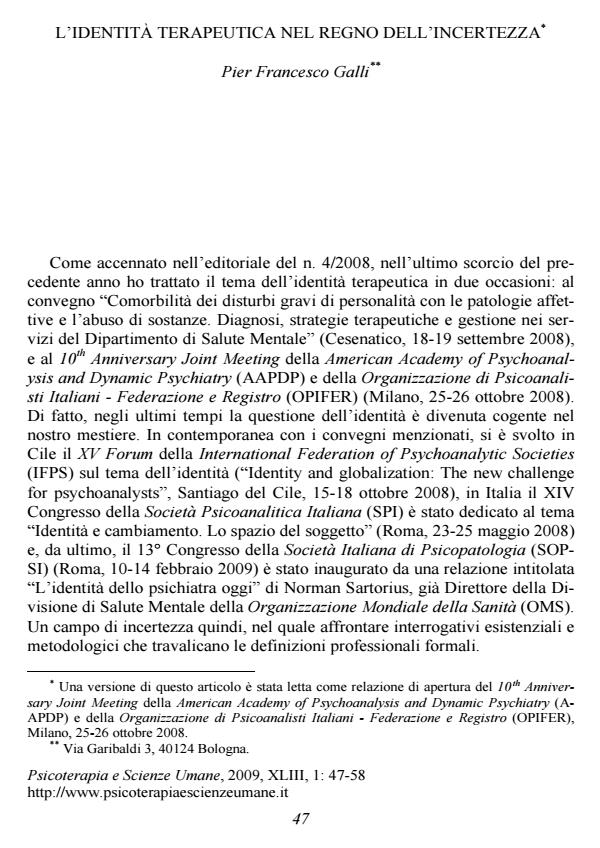L'identità terapeutica nel regno dell'incertezza
Titolo Rivista PSICOTERAPIA E SCIENZE UMANE
Autori/Curatori Pier Francesco Galli
Anno di pubblicazione 2009 Fascicolo 2009/1
Lingua Italiano Numero pagine 12 P. 47-58 Dimensione file 54 KB
DOI 10.3280/PU2009-001003
Il DOI è il codice a barre della proprietà intellettuale: per saperne di più
clicca qui
Qui sotto puoi vedere in anteprima la prima pagina di questo articolo.
Se questo articolo ti interessa, lo puoi acquistare (e scaricare in formato pdf) seguendo le facili indicazioni per acquistare il download credit. Acquista Download Credits per scaricare questo Articolo in formato PDF

FrancoAngeli è membro della Publishers International Linking Association, Inc (PILA)associazione indipendente e non profit per facilitare (attraverso i servizi tecnologici implementati da CrossRef.org) l’accesso degli studiosi ai contenuti digitali nelle pubblicazioni professionali e scientifiche
Therapeutic identity in the realm of uncertainty - The theme of the therapeutic identity is discussed. Psychotherapy is a profession that, for its intrinsic characteristics, could be defined the "profession of uncertainty". This issues is discussed along three lines: the reconstruction of the psychotherapist’s personal identity through the autobiographic method (a method that some Italian historians call egostoria, i.e., "ego-history"); the definition of the training and educational processes which lead to professional identity; the foundation criteria of psychoanalytic method. The paper deals with the following problems, among others: the "clinical operation", psychoanalytic training, prevision in clinical work, and the criteria for the validation and measurement of clinical interventions. In the final part of the article the problems of diagnosis and of the indications for treatment both in psychiatry and psychoanalysis are discussed. [KEY WORDS: psychotherapist’s identity, autobiography, psychoanalytic method, diagnosis, clinical prevision];
- Come gestire la pluralità dei modelli in psicoterapia Pier Francesco Galli, Alberto Merini, Paolo Migone, in PSICOTERAPIA E SCIENZE UMANE 3/2023 pp.479
DOI: 10.3280/PU2023-003009 - Colonialismo e Chiesa cattolica durante la dittatura di Salazar (1940-1954) Marialuisa Lucia Sergio, in STORIA E PROBLEMI CONTEMPORANEI 90/2023 pp.85
DOI: 10.3280/SPC2022-090006
Pier Francesco Galli, L'identità terapeutica nel regno dell'incertezza in "PSICOTERAPIA E SCIENZE UMANE" 1/2009, pp 47-58, DOI: 10.3280/PU2009-001003